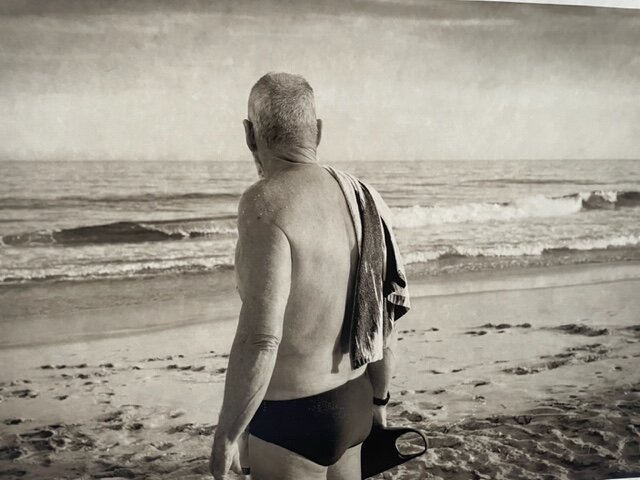Who Is Leaving Free Sculptures at Wainscott's Town Line Beach & Why?

Shakespeare said “All the world’s a stage,” but what if it’s also a gallery or at least a place filled with art?
George Mittendorf, an East Hampton resident, has displayed his work at various galleries and venues. It has appeared at the Benson Art Gallery and Renchler Gallery in Bridgehampton. But the artist has begun providing pieces free to beachgoers who discover and then take home the sculptures suspended on a fence.
While other people may ask, “Where’s Waldo?” the question as to where George’s artwork is may be a very real one during East End summers.
“My idea was with all the inequality in the world that artists could give some of their artwork away,” he says.
Mittendorf sees providing work free as a way of sharing his sculptures with anyone who takes one.
“I decided I would give away pieces I was making of a certain type,” he adds. “I would distribute them by leaving them at the beach.”
As Mittendorf sees it, “free art” is one method of distribution.

“I’m not asking you to give everything away, but maybe make something that you can give away,” Mittendorf says.
“Usually I make it so it comes apart,” he adds of his work. “And people can put it back together again.”
Mittendorf says other artists don’t necessarily love the idea of giving away art (though he’s not the first to do it in the Hamptons).
“They may think, ‘We don’t want other people thinking art should be free,’” he continues. “’We’re trying to build a market.’”
Still, Mittendorf notes that many art forms, and some artists, did give away art, at least at the start.
“That’s how hip hop and rap started on the street. It was free,” he says. “They were doing it in the street.”
Mittendorf makes his pieces and hangs them on a friendly and supportive neighbor’s fence near the Town Line Road Beach.
“People say, ‘I get what it is. I think I’ll take that home,’” he says.
Mittendorf simply fastened work to a fence. “People thought if they took something free that they were stealing it,” he says. “It’s very hard for people to understand you can’t steal a gift. A gift is free.”
Now he hangs the work near a message indicating that the work is meant to be taken. There is a hand-lettered sign, saying, “Take 1 or make 1. This is 4 you.”
“Quite a few people I know have taken them,” Mittendorf says.
His sister saw an article about an art collector and one of these sculptures was included.
“Most people take them and hang them in a similar situation, outside a building or on a fence next to their pool. Or, they put it over their mantelpiece,” he says. “They’re easy to hang up. All you need is a pushpin. Some you can stand up.”
About 100 artworks have been distributed this way, according to Mittendorf who described how he makes these pieces.

“I assemble it in a pentaweave and hang it,” he says. “Over the Fourth of July weekend, five or six will be taken. They tend to disappear on holiday weekends.”
Who are the people who feel moved to take, not steal, this art?
“People who know something about art take them,” he says. “Other people look at them and find them a little intimidating.”
Art, he said, is at least in part about creating something new and original. “They’re all different, like snowflakes,” Mittendorf adds. “You can never make something exactly like something else.”
Some were stamped with his name and a copyright, but he no longer typically does that.
“Some people know who it is,” he says. “Some people don’t.”
He sees unsigned art as a departure from the art market.
“If Jasper Johns did the same thing, it’d be worth several million dollars, because his name was on it,” Mittendorf says. “If Picasso had done it, it’d be worth many millions.”
Mittendorf is creating objects of value, in this case, based on viewing pleasure not price.
“If you’re commissioned to do a piece, that’s one thing,” he says. “This is work I’m willing to do and give away.”
As the work was, and is, placed anonymously until now, its intention was never for publicity.
It sounds as if he is happy to provide gifts to strangers who find art waiting for them. People take the work not simply as a souvenir, but a sign of understanding art.
“If people like them, they take them and find resting places where the pieces are appreciated,” he says.



